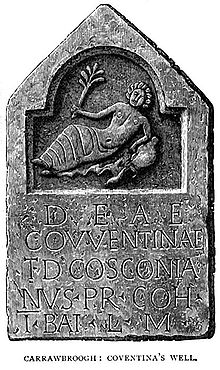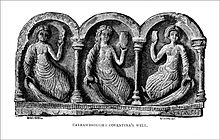- Coventina
-
Coventina war in der Britannischen Mythologie eine Heil- und Quellgöttin, die am Hadrianswall verehrt wurde.
Inhaltsverzeichnis
Das Heiligtum
Für Coventina errichteten die am Hadrianswall stationierten Legionäre ein Heiligtum im Fort VII von Brocolita (Carrawburgh, Northumberland). Der quadratische Tempel wurde über einer noch heute aktiven Quelle gebaut („Coventina’s well“) und 1876 ausgegraben. Im Becken sind über 13.000 Münzen und bronzene Tierfiguren gefunden worden.[1] Ebenfalls darin lagen die offenkundig später hineingeworfenen Weihesteine und Altartrümmer. Inschriftlich sind mindestens dreizehn Weihungen an Coventina nachgewiesen. Außerdem wurden im Tempelareal drei dem Gott Mithras geweihte Altäre aufgefunden.
Das Flachrelief rechts zeigt die Göttin auf einem Blatt liegend mit einer Pflanze in der Hand. Es wurde nach der Inschrift von Titus D(omitius?) Cosconianus, Präfekt der 1. Bataver-Kohorte dediziert.[2]
- Deae
- Couventinae
- T(itus) D() Cosconia-
- nus pr(aefectus) coh(ortis)
- I Bat(avorum) l(ibens) m(erito)
Das linke Relief zeigt eine Dreiheit (Triaden) mit einem Becher in der einen und Wasser ausgießenden Urnen in der anderen Hand. Hier werden die Figuren in der Inschrift als Nymphen (nimpha, nimfa) bezeichnet.[3]
Drei weitere gefundene Weiheinschriften (zwei in Spanien, eine in der Gallia narbonensis) könnten sich ebenfalls auf Conventina beziehen, dies ist jedoch umstritten.
Siehe auch
Literatur
- Helmut Birkhan: Kelten. Versuch einer Gesamtdarstellung ihrer Kultur. Verlag der Österreichischen Akademie der Wissenschaften, Wien 1997, ISBN 3-7001-2609-3.
Einzelnachweise
- ↑ Bernhard Maier: Lexikon der keltischen Religion und Kultur. Kröner Verlag, Stuttgart 1994, ISBN 3-520-46601-5, S. 87 f.
- ↑ Hermann Dessau, Inscriptiones Latinae selectae (ILS), Nr. 4725; Abbildung.
- ↑ Helmut Birkhan: Kelten. Versuch einer Gesamtdarstellung ihrer Kultur. Verlag der Österreichischen Akademie der Wissenschaften, Wien 1997, ISBN 3-7001-2609-3, S. 625.
Wikimedia Foundation.


